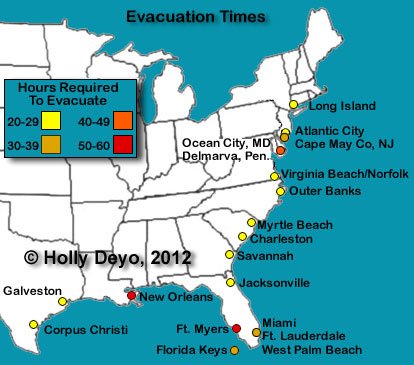Every person will face an ugly new reality when life as we know it vanishes. It?s coming. Soon. It might be a slow crawl decline or a rapid descent into nightmarish conditions. Various scenarios now flit threateningly across the horizon. If we?re brave enough to peer into the abyss, we can see some of these events bordering on fruition. Most are unnerving; some will be paralyzing. Regardless of the fright factor, we?must?examine individually how to handle these looming crises. When they strike,?people without a plan in place,?will die.
So what?s lurking about?
GRID DOWN
What threatens us now is nothing we?ve ever experienced. Life would change unspeakably from a mega-disaster dwarfing Hurricane Katrina. Catastrophic grid failure from EMPs or the Sun throwing a massive CME at Earth would instantly hurl much of the globe into 3rd world conditions. There?is?precedence.
October 2003 the Sun shot off a life-withering X45 mega-flare. This was more than?twice?as?big?as any previous event. The only thing that saved us from a grid-down catastrophe was this raging storm erupting away from Earth. Had this been Earth-directed, you would not be reading this article now. Life would have changed cataclysmically.
Photo above right: ?The biggest previous solar flares on record were rated X20, on April 2, 2001 and August 16, 1989. So 2003?s explosion certainly set a new mark. But only now do scientists understand the probable true power of the event. The New Zealand researchers in Otago looked at the effect the flare?s radiation had on the Earth?s upper atmosphere and used that to judge its strength. The changes the Otago researchers saw allowed them to produce a new estimate of the flare?s intensity, Increasing its rating from X28 to X45. ?This makes it more than twice as large as any previously recorded flare,? said Associate Professor Neil Thomson.? (SOHO)?1
Hardly any news source except the BBC reported this flare?s mammoth upgrade from a never-before seen X28 to X45 mega-flare status.
 ECONOMIC ARMAGEDDON
ECONOMIC ARMAGEDDON
Global economic meltdown or further terrorist attacks certainly loom larger based on recent events.
Image left. On October 24 (?Black Thursday?), the market lost $30 million or 11% of its value at the opening bell on very heavy trading. The next day, ?Black Tuesday?, October 29, 1929, about 16 million shares were traded, and the Dow lost an additional 30 points, or 12%.2
$30 million may seem like a mere drop today, but 8 decades ago it was cataclysmic. Today this inter-dependent economy is balanced on a pinpoint. Any ill-wind could blow it into oblivion.
 Photo right: On Sept. 12 this year, LukOil advertised $9 a gallon for gas in NJ and NY. While this was a protest sign, gas
Photo right: On Sept. 12 this year, LukOil advertised $9 a gallon for gas in NJ and NY. While this was a protest sign, gas
prices may escalate with a Middle East conflagration to the point where truckers simply can?t afford to transport goods. Since trucks distribute roughly 80% of everything we purchase, if they don?t move the goods, grocery stores and every other retail venue will die from economic strangulation. From that point, trouble travels in all directions to every aspect of life. Ripping the lid off all of America?s strategic oil reserves would only supply 36 days of fuel.
Experts suggest that when diesel reaches $6 a gallon, shipment of goods will slow drastically. At $7 a gallon, expect full shutdown.
FUKUSHIMA FUBAR (FOULED-UP BEYOND ALL RECOGNITION)
One often-ignored scenario involves a Fukushima-type event in the U.S., where one or more of our 104 nuclear reactors goes into meltdown. Of these 104 reactors, 23 were built just like the Fukushima Daiichi plant and over half of America?s reactors are 30-40 years old. Worse, instead of rebuilding or replacing these aging facilities, owners have applied for 20 years extensions.

What worsens the situation here is that the vast majority of spent fuel rods is stored on-site to the point of overflowing. That?s why it was imperative that alternative solutions be researched like the now-abandoned Yucca Mountain Repository in Nevada. Obama scuttled this project and wasted $90?billion?in taxpayers money. Meanwhile, the spent fuel rods continue to stack up.
Though these 23 ?precarious? power plants are mainly in the South, Midwest and Northeast, as seen with Fukushima, wind and water would carry their poison all over the U.S? all over the globe. So just because your state doesn?t host a nuclear reactor, you aren?t ?safe?. It?s like the firemen?s motto from?Backdraft: ?You go, we go.?
Now factor in this ugly thought?.
The Cumbre Vieja volcano sits just south of the U.S. off the northwest tip of Africa. I exposed this ?Sword of Damocles? a decade ago in?Prudent Places USA. In short, should the slipping side of this volcano continue its devastating slide into the ocean, it will slam a towering tsunami into America?s eastern seaboard within 8 hours. Even with notice the very instant this event begins, most of the East and Southeast coastal people will die. This mega-tsunami will wipe out everything in its path for 12-1?2 miles inland. It?s not that folks won?t?try?to evacuate, but when you ask tens of millions of people to move at once, massive gridlock follows. People can?t outrun, outdrive a body of water 165 feet high, traveling 450mph.
 Image: Check the evacuations times on the map on the right. Panicked people all converging on the highways and freeways simultaneously means these folks will end up going nowhere and likely die in their vehicles.
Image: Check the evacuations times on the map on the right. Panicked people all converging on the highways and freeways simultaneously means these folks will end up going nowhere and likely die in their vehicles.
Spurred by shear panic, people will tailgate causing innumerable wrecks. People will die from heart attacks simply from the stress. Still others will stop for a pee break because they didn?t the foresight to bring along a Lady J or Little John, or even a coffee can. All stops in traffic delays every single car. Every roadway in line of this mega-tsunami will become motionless parking lots.
OTHER UGLIES
More nasty disasters are also possible. People on the West Coast bravely ignore the ?Big One? while people throughout the heartland wait for a repeat of the dreaded New Madrid mega-quake.
Yellowstone is also long overdue for another mighty blow.
And lest we forget, new superbugs are being concocted in various Bio Level 4 labs around the country and around the world. These are in addition to an expected pandemic whether it comes in the form of H1N1 or some more deadly recombined flu, antibiotic-resistant MRSA, Necrotizing Fasciitis ? the incurable flesh-eating disease, or ebola set loose in America as a bio-threat. But there?s enough to worry about with the scenarios already listed without borrowing more, likely threats.
Any of these situations would mandate martial law.
MARTIAL LAW A CERTAINTY, POSSE COMITATUS DEAD
Hurricane Katrina brought innumerable valuable lessons beside the obvious that FEMA has its collective head up its nether-parts and remains reasonably useless. The only guy who ever had the courage to speak the truth was former FEMA director, James Lee Witt. Stan and I heard him in October 1996 warning Americans that they?d better prep up because FEMA simply couldn?t meet all the demands of the coming El Ni?o. Boy, was he right! Not only was he a maverick bucking government?s ?keep your mouth shut? protocol,?he was right.?FEMA is even more neutered now, made even less capable of bailing out people due to lack of funds and personnel.
Photo below left:??Emergency preparedness legislation and FEMA executive orders that have been in effect for decades, were suddenly put into use at the expense of basic freedoms. The Posse Comitatus Act was overturned as active duty military paraded the streets and aided police in confiscating firearms and implementing mandatory evacuation orders.? (Alex Jones,?Infowars)
 Second, the U.S. is not prepared for major crises. Compared to 2005, we have less available rescue personnel and more depleted coffers to fund disaster relief.
Second, the U.S. is not prepared for major crises. Compared to 2005, we have less available rescue personnel and more depleted coffers to fund disaster relief.
Third, cops will and do?shoot people?during disaster chaos.
Fourth,?martial law?has been enacted in America. Just wait till we see another crisis of even greater magnitude. Citizens will be stuck in their homes, at gunpoint, with little recourse and fewer options, if no plan of action is in place.
Fifth, Posse Comitatus is dead. That long held promise of keeping US troops from turning on Americans is gone. Again, it started with Hurricane Katrina. (Between that and the 911 attacks, what events have done more to extinguish civil rights?) Posse Comitatus was demolished in 2008 as part of the?Defense Authorization Bill. Foreshadows of this shocking transition developed after Katrina when the Pentagon proposed to?use military reservists during natural disasters. Be sure to click on the additional 12 articles right under?Pentagon Proposal to Use Military Reservists in Natural Disasters Angers States? Governors?addressing this disturbing legislation.
Katrina was the perfect springboard. From there it is a hop/skip to condition Americans seeing military corral citizens and become defacto prison guards.
Shocker: Whoever over age 30 thought we?d ever see America in this situation? Words fail this author?
IT SHOULD BE NOTED?
Stan and I come from a long line of distinguished military personnel, people who gave their lives for fellow Americans, made service to others their career. But these disasters have morphed our military into something foreign, something law promised we would never see again.
 DICHOTOMIES IN ACTION
DICHOTOMIES IN ACTION
We have close personal friends who are?Oathkeepers?and a neighbor within arm?s reach ? who, when questioned if he were ordered to kill fellow Americans ? remained silent. Fill in the blanks. This is yet another example of how fractured our Country has become.?Who kills fellow Americans?
PRACTICAL PREPAREDNESS ? WHERE CAN YOU BUGOUT?
So what can be done? What is in the realm of possibility ??not wishful thinking?
Preparedness pundits often suggest that people buy a bugout location, outfit it as a second home, but with the additional wallet-ripping caveat of making it self-sufficient. The dollars needed for such an expenditure mushroom into the staggering. When so many people have lost jobs and forfeited homes, the thought of buying an additional property sparks despair, if not outrage. All too often, ?experts? answer problems by throwing cash at them ??money most people don?t have right now. So what, only the well off should survive? Anyone can suggest ?money-solutions?, look to an easy answer, but that doesn?t work for most folks. Frankly, it?s a cheap-shot, easy answer to an expensive, tough problem.
RAGE UNMASKED
When things ?go south?, people will get angry.?Very angry.?They will want what you have. No one plans to work their butt off thinking some day it could be jerked away in a heartbeat by thugs or Executive Order. Yet these are the times and scenarios in which we live today. This photo below left is a ?pretty? picture compared to what?s coming. Wait till it?s?your?car,?your?home torched simply because people ?have not? and want yours. Then multiply that by tens of millions of angry militant masses. Riots will be the (lack) of order for the day and all in their way will be swept into turmoil.
 Most basic is food. The need to supply one?s family with adequate nutrition ranks right up there with breathing. Even if you have enough to spare a can of soup for neighbors, soon word will spread and you?ll be over-run by those in need, despite heartfelt promises to keep their lips zipped. How will you deal with hungry hoards of people?
Most basic is food. The need to supply one?s family with adequate nutrition ranks right up there with breathing. Even if you have enough to spare a can of soup for neighbors, soon word will spread and you?ll be over-run by those in need, despite heartfelt promises to keep their lips zipped. How will you deal with hungry hoards of people?
One solution is to face what comes right where you are. For that you need a plan in place and be ready.
IN SITU
The easiest and least expensive answer is to stay right where you are. Suppose you have a small family or one with only 2 adults. You?ll need 6 to 8 adults in the best case scenario to defend an average-sized residence. Most houses have roughly 4 directions to guard. This situation allows for 4 people on-watch and 2 to 4 to rest and perform other chores like cooking, sanitizing, etc. More people living in this space becomes cumbersome, too invasive and too difficult to sustain considering the space required for sleeping, to house stored water, food, ammo, weapons, medical supplies, etc. and to provide adequate sanitation if/when services go down.
If a person without funds looks like a really great addition to the group, whether in situ or going for a rental property, don?t automatically cross them off. This person might have great skills or supplies for barter. Sometimes these offerings are worth more than actual funds contributed and everybody wins.
On-site home defense is the easiest and least problematic solution providing you find the right partners to team with, as a great portion of your survival supplies are already in place. Plus, it keeps costs of a new property to zero.
Trust will be one of the biggest concerns. Con artists will ooze from the walls wanting handouts, offering to contribute everything, yet providing nothing. Some people have a really ?good read? on others, but disaster and necessity can cloud judgment. This requires razor sharp perceptivity and no-frills assessment. If people don?t ?feel right? to you, regardless of how desperate circumstances seem, give them a miss.?Hopefully the right people will fall across your path and serious prep inroads can be made.
NEIGHBORHOOD CHECK-UP
Nose around your neighbors. Check their prep temperature again. Discretely.
At our last month?s neighborhood dinner party, which Stan and I hosted a week ago, a decidedly different feeling permeated the air. Some that had shunned preparedness, not to mention firearms, changed their attitude ? hugely so. Previously, only about 1/4 of our group actively stored extra food and water. Last Sunday,?whoaa!?had the air become purified! Only 2 weren?t on board yet.
After champagne brunch, talk turned serious about current events and preparing. Maybe the light alcohol freed their tongues or maybe it was the unavoidable feeling of urgency, but something was definitely different.
One nurse mentioned she was surprised hearing so many radio PSAs (Public Service Announcements) urging personal preparedness. Another person commented that she could ?just feel something is wrong?. A third person, a detective in the Ca?on City prison system, offered his insights about a collective unease on the force.?All?the cops were talking about it, he said. A fourth person ? after 8 years of knowing him ? stated he now keeps his 357 Magnum under his bed, a rifle in the corner and various other weapons and ammo around his place. We didn?t even know he owned a firearm!
It was interesting to note that his wife, the only ?lefty? in the group, once she saw plague-ridden prairie dogs encroaching too close to her property last summer, asked Stan to come and shoot them. Funny how the worm turns when it?s about to screw up your apple. Attitudes change when it becomes personal. People usually caught up in boating, camping, traveling and other life pleasures are all sensing unease and the need to be ready.
POOLING:
Should in-situ work best, a complete inventory from all parties needs to be taken and shared with all members. Don?t hold back on personal ?holes? out of embarrassment. People must be honest to see the group?s shortcomings and strengths. Make a check list of supplies: food, medications, ammo/weapons and water purification, etc. Use our?Dare To Prepare?as your resource and guide, and our FREE ready-to-go?Deyo Food Storage Planner?(xls spreadsheet download)?for inventory taking. Items other than food can be added as needed. It?s a great user-friendly list to keep track of supplies on hand and spot areas to beef up.
Just the opposite of pooling supplies, get rid of excess space-wasting junk. People fare much better in less crowded spaces and a much-needed garage sale can fund extra cash for unintended expenses.
RENTING PROPERTY
Another solution is renting a viable property. This keeps your name ?off-book? providing better invisibility with your name off property tax records and deeds. Additionally it requires a considerably less investment than purchasing a second property. Divide that expense among 6 or 8 adults and the initial $$ needed further diminishes. Offer to pay 1 or 2 years in advance ? in cash ? and the amount due is chopped even further. This situation keeps you minimally exposed with more cash in pocket.
When looking for a second location, keep in mind the word ?survival?. That is the goal. Chances are a bugout place will not have all the amenities and comforts you?re used to. The prime question past affordability should be,?is it doable, is it a defensible location?
Try to locate a bugout not made of wood or with a shake shingle roof or with a wood deck attached. If someone tries to burn you out, the less combustibles available, the better. That said, many of the 359 homes lost in Colorado?s largest-ever fire this summer were built out of stucco with tiled roofs. When a fire is ferocious enough, nothing will stop it. However, fire resistant construction materials give you an edge against flame-throwing intruders.
Thinking to call the fire department? When things go this far into the dumper, firefighters will likely be drafted into chaos-quelling duty or at home protecting their own families, not fire protection. You will be on your own.
Before deciding on a rental house, check its location with regard to freeways, roads, high population areas, prisons, military installations, etc., proximity to poor areas, natural disasters, flooding and other undesirable scenarios. Check to see how visible it is to Google Earth and other intrusive software.
When you deem it time,?discretely?move whatever amount of survival supplies you decide is clever to this location. If really exposed in your current home, you may want to move everything to the rental. Or, you may choose to play both ends and keep supplies at each. Whatever the decision, make sure everything is in place before ?the day?.
 WATER
WATER
How many times have ?experts? advised to opt ONLY for property if it has an originating water source. What are the odds? If you live in the desert southwest, not strong. It?s not impossible, but don?t let this be the deciding factor if nothing else is available.
Maybe it has a well head with water naturally rising within only a few feet of the surface. In this instance, whether power stays on or not, the simplest hand pump can retrieve life-saving water. Otherwise a generator, solar power or some other means of alternate power will be required if stored water runs short.
When we lived in Australia, one of our two wells brought water within 18 feet of the surface, so great was the pressure and supply. However, in the high desert, things are considerably different.
STEAMED UP OVER THE TEAM UP
Before deciding to get in bed with someone, metaphorically speaking, honestly assess what bugs you about them and what you can learn to live with. This is something each team member must do. If someone is highly allergic to pets, hooking up to a group with dog and cat family members could be a challenge.
If kids? normal activities get on the nerves, it?s better to search for a different group. They?re just being kids and this isn?t going to change.
Additionally, if someone comes into the group just as a ?warm? body or place holder, resentment will build and frankly there?s no room for slackness in these scenarios. Lives depend on all participants, specially when small numbers are involved. Everyone must pull his or her weight in the agreed-upon manner.
Another source of friction can come with the division of property. It?s normally understood if you open up your home to others, newcomers get the spare rooms. However, if everyone goes into a rental, the situation becomes trickier and squabbling can ensue. People will need to agree on seemingly simple issues like closet and fridge space, bigger bedrooms vs. guest rooms, chores, utility costs and other expenses to divvy up. Chances are you?ll be in place weeks or maybe several months while ?real life? goes on until TSHTF.
INTENTIONAL COMMUNITIES
Cooperative living scenarios might sound great at first glance to those without a place to go, without adequate skills or feeling too exposed to go it alone. However, once a ?survival? population gets too far above single digit numbers, it becomes interesting to government or other groups vested in moving you to ?toes up? status. Smaller groups are less threatening to the powers that be, easier to organize, more mobile and less inclined to attract unwanted attention. Think small enough to be nearly invisible, large enough to be practical. Most importantly,?think now.
Whatever your decision, time grows short as winter sets in and threats loom ever closer.
ABOUT THE AUTHOR:
Holly Drennan Deyo is the author of three books: bestseller?Dare To Prepare (4th ed.),?Prudent Places USA (3rd ed.)?andGarden Gold (2nd ed.)?Please visit she and her husband?s website:?standeyo.com?and their FREE Preparedness site:?DareToPrepare.com.
References:
1?Sun?s Massive Explosion Upgraded, March 17, 2004, By Dr David Whitehouse, http://news.bbc.co.uk/2/hi/science/nature/3515788.stm.
2?Wall Street Crash of 1929, http://en.wikipedia.org/wiki/Wall_Street_Crash_of_1929
http://standeyo.com/NEWS/12_USA/120924.bugout.alternatives.html
Source: http://www.shtfplan.com/emergency-preparedness/alternatives-to-a-bugout-location-what-you-should-consider_09242012
bully bohemian rhapsody bohemian rhapsody spike lee carson daly heejun han donovan mcnabb
 Computer terminology can be one of the hardest things to wrap your head around. It?s can all seem like mumbo jumbo, with made-up or adopted words. Some of the more confusing terminology comes from programs and software with harmful intent. Is the program infecting your computer a Trojan horse, worm or malware though? It can be hard to differentiate them sometimes.
Computer terminology can be one of the hardest things to wrap your head around. It?s can all seem like mumbo jumbo, with made-up or adopted words. Some of the more confusing terminology comes from programs and software with harmful intent. Is the program infecting your computer a Trojan horse, worm or malware though? It can be hard to differentiate them sometimes. ? The Investor?s Anthology: Original Ideas from the Industry?s Greatest Minds by Charles D. Ellis
? The Investor?s Anthology: Original Ideas from the Industry?s Greatest Minds by Charles D. Ellis


 ECONOMIC ARMAGEDDON
ECONOMIC ARMAGEDDON Photo right: On Sept. 12 this year, LukOil advertised $9 a gallon for gas in NJ and NY. While this was a protest sign, gas
Photo right: On Sept. 12 this year, LukOil advertised $9 a gallon for gas in NJ and NY. While this was a protest sign, gas
 Image: Check the evacuations times on the map on the right. Panicked people all converging on the highways and freeways simultaneously means these folks will end up going nowhere and likely die in their vehicles.
Image: Check the evacuations times on the map on the right. Panicked people all converging on the highways and freeways simultaneously means these folks will end up going nowhere and likely die in their vehicles. Second, the U.S. is not prepared for major crises. Compared to 2005, we have less available rescue personnel and more depleted coffers to fund disaster relief.
Second, the U.S. is not prepared for major crises. Compared to 2005, we have less available rescue personnel and more depleted coffers to fund disaster relief. DICHOTOMIES IN ACTION
DICHOTOMIES IN ACTION Most basic is food. The need to supply one?s family with adequate nutrition ranks right up there with breathing. Even if you have enough to spare a can of soup for neighbors, soon word will spread and you?ll be over-run by those in need, despite heartfelt promises to keep their lips zipped. How will you deal with hungry hoards of people?
Most basic is food. The need to supply one?s family with adequate nutrition ranks right up there with breathing. Even if you have enough to spare a can of soup for neighbors, soon word will spread and you?ll be over-run by those in need, despite heartfelt promises to keep their lips zipped. How will you deal with hungry hoards of people? WATER
WATER
